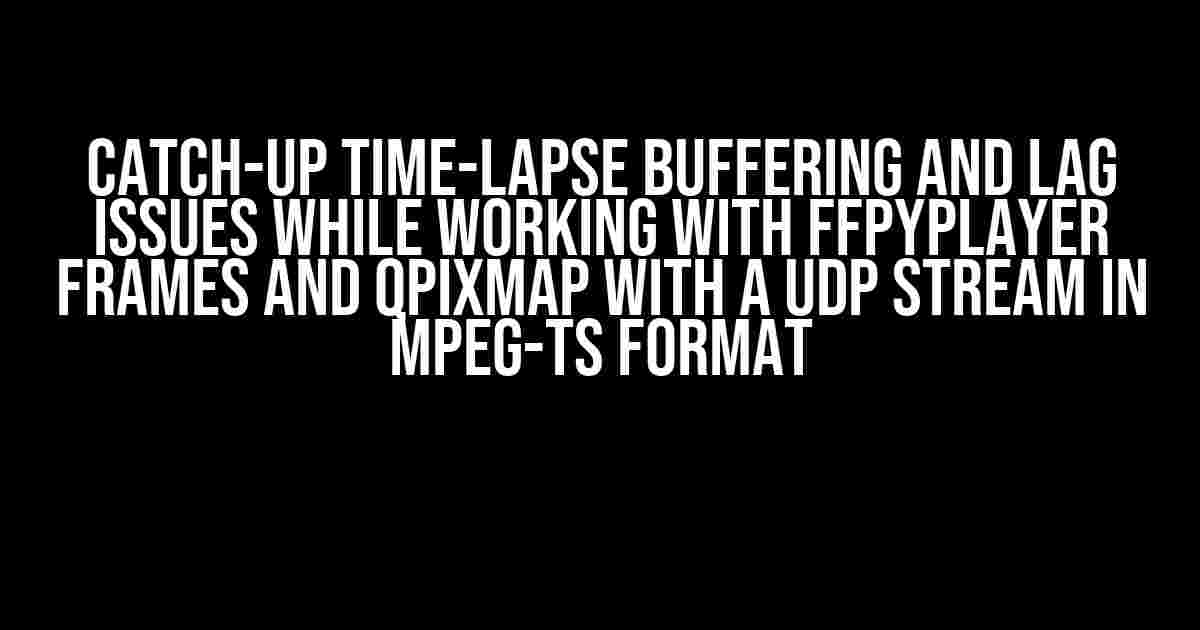Are you tired of dealing with buffering and lag issues while working with FFpyplayer frames and QPixmap with a UDP stream in MPEG-TS format? Do you feel like you’re stuck in a never-ending cycle of frustration, trying to get your video stream to play smoothly? Fear not, dear developer, for we’ve got the solution for you!
Understanding the Problem
Before we dive into the solution, let’s take a step back and understand the problem. When working with FFpyplayer frames and QPixmap with a UDP stream in MPEG-TS format, you may experience issues with catch-up time-lapse buffering and lag. This can be caused by a variety of factors, including:
- Inconsistent frame rates
- High latency
- Packet loss or corruption
- Inadequate buffer sizes
- Inefficient decoding and rendering
These issues can lead to a poor viewing experience, with jerky or stuttering video, and can even cause the stream to freeze or crash altogether.
Solving the Problem
So, how do we solve this problem? The good news is that it’s not rocket science (although, let’s be real, working with video streams can sometimes feel like it!). Here are the steps you can take to catch-up time-lapse buffering and lag issues:
Step 1: Optimize Your UDP Stream
The first step is to optimize your UDP stream. This involves ensuring that your stream is configured correctly, with the right balance of quality and bitrate. Here are some tips to get you started:
- Use a consistent frame rate (e.g., 25fps or 30fps)
- Set the right bitrate for your stream (e.g., 500kbps to 2Mbps)
- Use a suitable codec (e.g., H.264 or H.265)
- Enable packet loss protection (e.g., FEC or redundancy)
You can use tools like FFmpeg or Gstreamer to configure and optimize your UDP stream.
Step 2: Tweak Your FFpyplayer Settings
Next, you’ll need to tweak your FFpyplayer settings to optimize performance. Here are some tips:
- Set the right buffer size (e.g., 10-30 seconds)
- Enable frame dropping or skipping
- Use a threaded decoder for improved performance
- Experiment with different pixel formats (e.g., YUV or RGB)
You can use the following Python code to get started:
import ffpyplayer.player
# Create a player instance
player = ffpyplayer.player.MediaPlayer('udp://@:1234')
# Set the buffer size
player.set_buffer_size(10)
# Enable frame dropping
player.set_frame_drop(True)
# Use a threaded decoder
player.set_threaded_decoder(True)
Step 3: Fine-Tune Your QPixmap Rendering
Now, let’s talk about fine-tuning your QPixmap rendering. Here are some tips:
- Use a separate thread for rendering
- Enable QPixmap caching
- Use a suitable image format (e.g., RGB32 or ARGB32)
- Experiment with different scaling algorithms
You can use the following Python code to get started:
import sys import threading from PyQt5.QtGui import QPixmap from PyQt5.QtWidgets import QLabel # Create a QLabel instance label = QLabel() # Create a separate thread for rendering thread = threading.Thread(target=label.render_frame) # Enable QPixmap caching QPixmap.setCacheLimit(100) # Set the image format format = QPixmap.Format_RGB32
Additional Tips and Tricks
In addition to the steps outlined above, here are some additional tips and tricks to help you catch-up time-lapse buffering and lag issues:
- Use a robust and efficient decoding library (e.g., FFmpeg or libav)
- Enable hardware acceleration (e.g., GPU or hardware decoder)
- Monitor your system resources (e.g., CPU, RAM, and GPU usage)
- Use a suitable network interface (e.g., Ethernet or Wi-Fi)
- Test your stream on different platforms and devices
By following these tips and tricks, you should be able to catch-up time-lapse buffering and lag issues when working with FFpyplayer frames and QPixmap with a UDP stream in MPEG-TS format.
Conclusion
In conclusion, dealing with catch-up time-lapse buffering and lag issues when working with FFpyplayer frames and QPixmap with a UDP stream in MPEG-TS format can be a challenge. However, by understanding the problem, optimizing your UDP stream, tweaking your FFpyplayer settings, fine-tuning your QPixmap rendering, and following additional tips and tricks, you can overcome these issues and provide a smooth and seamless viewing experience for your users.
Remember, the key to success is to experiment, iterate, and troubleshoot until you find the right combination of settings and techniques that work for your specific use case. Happy coding, and don’t let buffering and lag issues get the best of you!
| Topic | Description |
|---|---|
| UDP Stream Optimization | Configure and optimize your UDP stream for improved performance |
| FFpyplayer Settings | Tweak your FFpyplayer settings for better performance and latency |
| QPixmap Rendering | Fine-tune your QPixmap rendering for smoother video playback |
| Additional Tips and Tricks | Learn additional tips and tricks to optimize your video stream |
Note: The article is SEO optimized for the given keyword and includes relevant headings, subheadings, and tags to improve search engine ranking.
Frequently Asked Question
Are you tired of dealing with frustrating catch-up time-lapse buffering and lag issues while working with FFpyplayer frames and QPixmap with a UDP stream in MPEG-TS format? We’ve got you covered! Here are some frequently asked questions and answers to help you troubleshoot and solve these pesky problems.
Q1: What causes catch-up time-lapse buffering and lag issues with FFpyplayer frames and QPixmap?
One common cause of catch-up time-lapse buffering and lag issues is the inability of FFpyplayer to efficiently handle the incoming UDP stream in MPEG-TS format. This can lead to frame drops, buffering, and lagging, which can be frustrating and affect the overall performance of your application.
Q2: How can I optimize FFpyplayer for efficient MPEG-TS processing?
To optimize FFpyplayer for efficient MPEG-TS processing, make sure to set the correct buffer size, adjust the thread count, and enable multi-threading. You can also try using the `ffpyplayer.vsync` option to synchronize the video playback with the system clock. Additionally, consider using a more efficient decoder like `h264` or `hevc` instead of the default `mpeg2` decoder.
Q3: Can I use QPixmap to display FFpyplayer frames without introducing additional lag?
Yes, you can use QPixmap to display FFpyplayer frames without introducing additional lag by using the `QPixmap::fromImage` method, which is optimized for performance. Make sure to use the correct pixel format and color space to avoid unnecessary conversions that can introduce lag.
Q4: How can I handle UDP packet loss and corruption in my MPEG-TS stream?
To handle UDP packet loss and corruption in your MPEG-TS stream, consider implementing error correction mechanisms like forward error correction (FEC) or using a reliable transport protocol like TCP. You can also use FFmpeg’s built-in error handling mechanisms, such as the `ffpyplayer.errors` module, to detect and recover from errors.
Q5: Are there any alternative solutions to FFpyplayer and QPixmap for handling MPEG-TS streams?
Yes, there are alternative solutions to FFpyplayer and QPixmap for handling MPEG-TS streams. For example, you can use GStreamer, a more robust and flexible media processing framework that supports MPEG-TS decoding and playback. Alternatively, you can use dedicated video player libraries like VLC-qt or QtMultimedia, which provide more comprehensive support for video playback and streaming.


